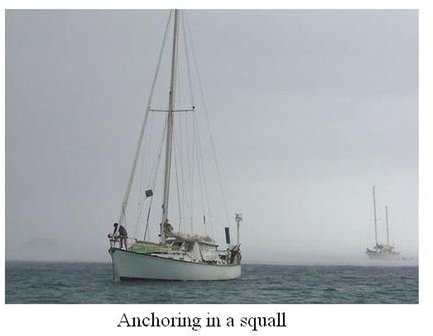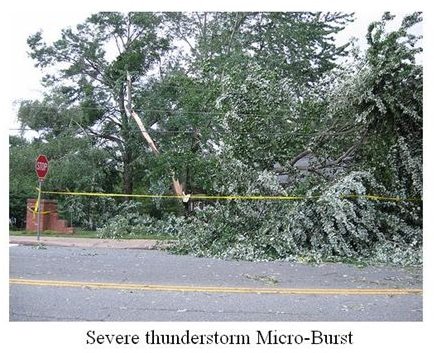What are Marine Heat Bursts, Microbursts, and Downbursts?
What is a Heat Burst?
A heat burst is a downdraft of hot, dry air that normally takes place in the evening or during the night. It is much rarer than a harsh thunderstorm. Therefore, the atmospherical preconditions must be exactly right for a heat burst to take place. Heat bursts generally occur after thunderstorms end.
Features of a heat burst:
- A thunderstorm has a very important role in activating heat bursts.
- The air must initiate its fall from a higher altitude.
- And the air uphill has to be very dry.
Precipitation descending into very dry air uphill will induce the air to chill by dormant heat absorption. When the conditions are such that the air flows at a very high altitude and is denser than the contiguous air, then it will gather speed towards the surface. With regard to a heat burst, all the precipitation that chilled the air uphill has been “aerified,” or infused with air.
Consequently, the precipitation is no longer able to take up any more underlying heat. The impenetrable air then accelerates and warms up at a fast pace with a dry adiabatic descent rate density. The reason for a heat burst being a rare phenomenon is because it depends on the very high velocities of a downdraft. The velocity of a downdraft must be so high that the momentum of the sinking air offsets the fact that it is getting warmer in temperature and less dense than the air it is descending into.
The air in a heat burst is not only anomalously hot, but also very dry. Similar to other atmospherical processes, heat bursts have variable strengths. The strongest heat bursts may continue for a significantly longer time with temperatures reaching as high as 120 F, even halfway through the night. This exceedingly hot and dehydrated air can continue for a number of hours before temperatures become normal. Temperatures of 90 °F (32 °C) during heat bursts have been recorded and sometimes have been observed increasing by 20 °F (11 °C) or above in a few minutes. Heat bursts are also sometimes coupled with very powerful, even destructive, winds.
Meteorologist Mike Smith, from WeatherData writes: “A ‘downburst’ is a unique form of extreme winds unknown to meteorologists prior to 1977 when it was discovered by Drs. Ted Fujita and Horace Byers. While they can occur anywhere, the Dallas area has bitter experience with downbursts.” Let us look at what these downbursts are!
Microburst Damage
What are Downbursts?
A downburst is a potent downdraft formed by a convective storm that induces destructive winds for five to thirty minutes. When identified, downbursts can be separated as microbursts and macrobursts. Microbursts are characterized by their winds being horizontally defined which are less than four kilometers so that only a smaller area is struck, but sometimes it may also result in higher wind speeds. Winds from a macroburst extend beyond four kilometers but have limited wind speed. Downbursts can also be divided into wet or dry.
Definition of Downbursts
A downburst is formed by a column of dropping air that, after reaching ground surface, disseminates in all directions and is capable of developing destructive straight-line winds at more than 150 mph, that is 240 km/h. Downburst destruction will spread out from a middle point as the sliding column disseminates out when touching on the surface.
Formation of a Downburst
The development of a downburst begins with hailstones or huge raindrops descending through drier air. Hailstones dissolve and raindrops vaporize- an endothermic course that requires lots of energy in the type of hidden heat so that the air cools. Cooler air has a greater mass than the warmer air around it, thus dropping down in the form of a “cold air balloon.” Once it touches the ground, it disseminates in a mesoscale (meaning “local” in meteorology, although it may range up to a few hundred kilometers) movement that can be detected as squall movement. Any region directly adjacent to the downburst will get the maximum winds and rainfall.
At the same time as the air cooled by the rain descends, a noteworthy dip in temperatures is discovered. On interacting with the ground, the downburst rapidly drops off its strength as it strikes out and shapes the characteristic “coil shape” that is normally seen at the margin of the microburst. Downbursts generally hold out only for a few minutes and then break up. Nevertheless, in spite of their short duration, microbursts are a severe danger to aviation and property, resulting in considerable damage to the area in which they occur. Thus the growth phases of downbursts can be of three stages, that is the contact stage, the outburst stage, and the cushion stage.
Wet and Dry Micro Downbursts
Wet downbursts are coupled with a falling core of dense precipitation, possibly mixed with unsaturated air from mid-levels. These downbursts appear ominous, in any case in the daytime, and are dependably observed by radar. They are easy to fend off.
Dry downbursts are more threatening. The vapor of droplets falls into a bottomless sheet of somewhat dry air beneath a high cloud foundation in the company of a sharp slip rate, inducing dry downbursts. Such air experiences fast decreases in temperature with height, about 1°C for each 100 m of altitude. When the droplets are small, more in number, and they do not fully vaporize until they reach the ground, then the high velocity air can speed up as much as necessary to create radial outpourings beyond 30 m. Occasionally the sole visual signal is a spherical ring of drifting dust at the ground.
Physical Processes of Dry and Wet Microbursts
In case of wet microburst, the environment is hot and humid in the subordinate strata and dry uphill. Consequently, when electrical storms arise, heavy rain is brought forth although some of the rain vaporizes in the drier air uphill. Therefore the air uphill is cooled inducing it to descend and disperse out quickly as it collides with the ground. Thus, both strong destructive winds and intense rainfall occurs in the same area. In case of dry microburst, the environment is tepid but dry in the subordinate levels and humid uphill. The result- showers and thunderstorms build up, while most of the rain vaporizes before it reaches the ground.
Squall lines
A white squall is the cause of many sea reports and is responsible for quite a few disasters. It is traced as an abrupt boost in wind speed in humid and sub-tropical waters, and these are not the normal dark, threatening squall clouds. If they develop during daytime their approach can be noted as a line of depressed water or white horse (aka whitecap) hastening at your vessel, but normally they come out of nowhere.
The white squall is so dangerous that it sank “The Pride of Baltimore,” an excellent 137-foot modern day replica of an early 1880s sailing vessel, when it was struck in 1986. The 121-ton sailing vessel went down about 240 miles north of Puerto Rico, throwing the existing crew members floating for five days. An observer accounted the sinking as follows:
“A tremendous whistling sound suddenly roared through the rigging and a wall of wind hit us in the back. The Pride heeled over in a matter of seconds. The 70-knot wind pushed a 20 foot high wall of water into the starboard side. She sank in minutes." (Source courtesy “White squalls blamed for many sinkings”)
Anchoring during a Squall

Risk to Aviators and Mariners Due to Microbursts
Downbursts, particularly microbursts, are not only destructive to objects on the ground, but also dangerous to airplanes. When a plane is landing, or even while it is taking off, it is defenseless against running into strong downdrafts which can force the plane into the ground. The most horrible instance of this occurrence was Delta Flight 191 outside Dallas, Texas in 1985. When it was landing the plane ran into a thunderstorm and was flipped aggressively before being thrown to the ground in a microburst. About 135 people were killed in the crash.
The effects of downbursts are in most of the cases linked to aviation, but in certain cases they can also be detected in marine conditions. Such conditions include wind velocity and course at the outside, waves produced and their altitude, or water level changes. A downburst is able to momentarily push these conditions to their utmost, inducing a possible risk to property or human lives. Small craft like water taxis or entertaining vessels are very vulnerable to high wind speeds.
Conclusion
Thus microbursts can cause severe dangers to the marine environments. It is obvious that the short duration of a microburst permits for noteworthy increments in water level. This results in significant increase in wave movement as well, which is a fundamental peril to marine craft, particularly in port areas. Wind velocities of 35 to 40 knots are capable to bring in water level differences of 4” over a 10 to 15 minute period. Wind with a speed of 45 to 50 knots during the same time period is able to cause larger increments between 0.8 and 0.9 feet. Hence we can conclude that wind velocities and water level alterations ensuing from convective downbursts develop detectable and potential risky conditions for marine craft. Nevertheless due to research performed after the Delta crash, much has been learned about weather bursts, micro, macro, and heat bursts, since the tragedy of that evening.
References
University of Illinois - Microbursts
Jack Williams - The USA Today Weather Book
John Brandon - Hazards encountered in and near thunderstorms
Caracena, Holle, and Doswell - Microbursts –A handbook for visual identification
Image by Bsabarnowl - Severe thunderstorm Micro-Burst
Image by Flying Tuba - Anchoring in a squall
